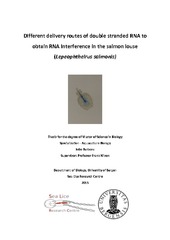Different delivery routes of double stranded RNA to obtain RNA Interference in the salmon louse (Lepeophtheirus salmonis)
Master thesis
Permanent lenke
http://hdl.handle.net/1956/12588Utgivelsesdato
2016-05-31Metadata
Vis full innførselSamlinger
Sammendrag
Lepeophtheirus salmonis (Krøyer 1837), commonly known as the salmon louse, is an ectoparasitic copepod specific to wild and farmed salmonids (Boxaspen, 2006), and probably the most serious problem that the Norwegian Aquaculture Industry faces in modern times. It is estimated that costs related to salmon louse control have reached 5 billion NOK in 2015 (Frank Nilsen, 2016, personal communication). The extraordinary increase in production of salmonids by Norwegian Aquaculture Industry since the 1970s (reached 1.5 million tonnes in 2009) (Torrissen et al. 2011) coupled with the limited amount of chemotherapeutants available to treat salmon louse infestation have led to a rise in parasite resistance and reduced sensitivity to available treatments (Denholm, 2002; Hosberg, 2012). This trend has created a demand for alternative treatment methods, of which the most coveted is an efficient vaccine. Two studies have been published in which candidate antigens were tested on Atlantic salmon (Grayson et al., 1995; Carpio et al., 2011) but none of them produced the desired outcome of drastic reduction in the number of lice and lice fitness. The sequencing, assembly and ongoing annotation of the salmon louse genome has provided researchers with a wide range of possible new treatment targets and potential vaccine antigens. The Sea Lice Research Centre (SLRC), where this work is being pursued, has already started the evaluation of several of those targets (Dalvin et al. 2009, 2011; Eichner et al. 2014, 2015a, 2015b, 2015c; Sandlund et al., 2015). A very relevant molecular technique used in this exploration process has been RNA interference (RNAi), a phenomenon by which gene transcription downregulation is achieved upon introducing of dsRNA molecules homologous to the target mRNA. There is, however, little information on how RNAi is achieved in the louse, namely which proteins are involved in the transport of dsRNA into the cytosol. In C. elegans, the model organism for RNAi, the SID-1 protein has been identified as a selective importer of extracellular dsRNA. The present study attempted to induce the transcriptional knock-down via RNAi of LsSID1a and LsSID1b, two genes that encode two putative SID-1 like proteins in L. salmonis, in order to verify their effect in the systemic gene knock-down of other known genes. RNAi in the salmon louse was attempted via intestine injection, cephalothorax injection and by mixing Atlantic salmon blood with dsRNA (blood+dsRNA) and feeding it to pre-adult II male lice. Results show that intestine micro injection is not a viable dsRNA delivery method in the salmon louse but show promise when it comes to blood+dsRNA feeding. LsSID genes knock- down was not achieved via cephalothorax injection, although other target genes were successfully knocked-down using that same dsRNA delivery method. Additionally, results from this study show it is possible to detect dsRNA in the louse after it is fed blood+dsRNA and there is also a potential downregulation of LsSID1b at 192h post-feeding using this method. Further investigation is nonetheless required as the gathered evidence is not strong enough to unequivocally confirm this hypothesis.
